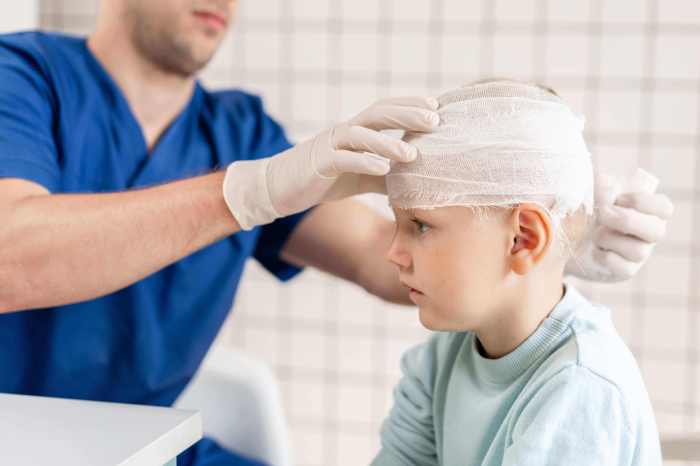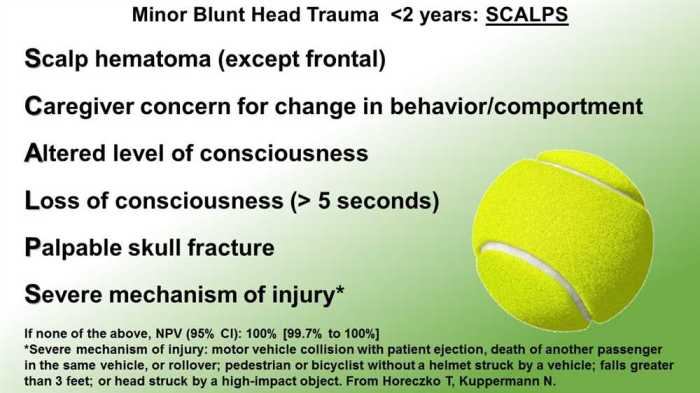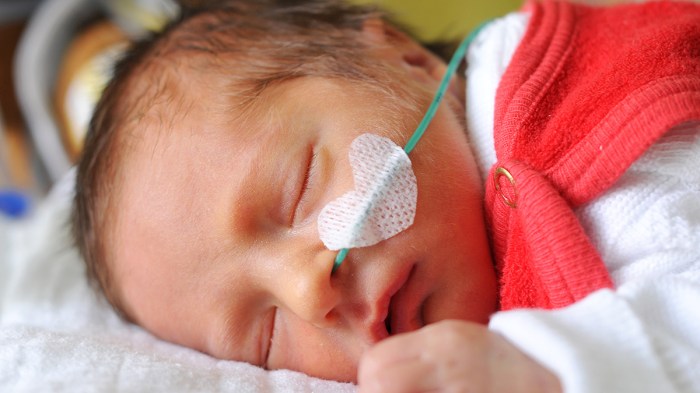Welcome to our comprehensive pediatric abusive head trauma quiz answers guide. This resource has been meticulously crafted to provide you with an in-depth understanding of PAHT, its diagnosis, treatment, and prevention. Whether you are a medical professional, caregiver, or simply seeking knowledge, this guide will empower you with the information you need.
Within these pages, you will find a thorough exploration of PAHT, including its definition, risk factors, signs and symptoms, diagnostic criteria, treatment options, and preventive measures. We will also delve into the ethical and legal considerations surrounding PAHT, ensuring you have a well-rounded understanding of this critical topic.
Definition of Pediatric Abusive Head Trauma (PAHT)
Pediatric Abusive Head Trauma (PAHT) is a serious form of child abuse that involves inflicted traumatic brain injury to a child under the age of 2 years. It is characterized by a triad of symptoms: subdural hemorrhage, retinal hemorrhages, and encephalopathy.
PAHT is a leading cause of death and disability in young children, and it can have devastating long-term consequences.
Characteristics of PAHT
- Occurs in children under 2 years of age
- Triad of symptoms: subdural hemorrhage, retinal hemorrhages, encephalopathy
- Often occurs without an obvious history of trauma
- Can be fatal or cause permanent disability
Risk Factors and Causes of PAHT
- Poverty and social isolation
- Substance abuse
- Mental health issues
- Lack of parental knowledge or support
- Caregiver stress
Signs and Symptoms of PAHT
The signs and symptoms of PAHT can vary depending on the severity of the injury. Some common signs and symptoms include:
Physical Manifestations
- Lethargy
- Irritability
- Vomiting
- Seizures
- Apnea
- Bruising or swelling of the head
Neurological Manifestations
- Altered level of consciousness
- Pupillary abnormalities
- Focal neurological deficits
- Increased intracranial pressure
Behavioral Manifestations
- Loss of interest in surroundings
- Difficulty feeding
- Sleep disturbances
- Regression in developmental milestones
Diagnosis of PAHT

The diagnosis of PAHT is based on a combination of clinical findings and imaging studies. The diagnostic criteria for PAHT include:
- History of suspected non-accidental trauma
- Triad of symptoms: subdural hemorrhage, retinal hemorrhages, encephalopathy
- Absence of an alternative explanation for the injuries
Imaging Studies
- Computed tomography (CT) scan
- Magnetic resonance imaging (MRI)
Differential Diagnosis
It is important to rule out other conditions that can mimic PAHT, such as:
- Accidental head trauma
- Intracranial hemorrhage due to other causes
- Meningitis
- Encephalitis
Treatment of PAHT: Pediatric Abusive Head Trauma Quiz Answers

The treatment of PAHT depends on the severity of the injury. Treatment options may include:
Medical Interventions
- Intubation and mechanical ventilation
- Anticonvulsants
- Osmotic therapy
- Antibiotics
Surgical Interventions
- Craniotomy
- Subdural hematoma evacuation
- Retinal hemorrhage repair
Multidisciplinary Care
The treatment of PAHT requires a multidisciplinary approach involving:
- Pediatricians
- Neurosurgeons
- Ophthalmologists
- Social workers
- Child protective services
Rehabilitation
Children who have suffered PAHT may require extensive rehabilitation to address the physical, neurological, and developmental consequences of their injuries.
Prevention of PAHT
The prevention of PAHT is essential to protect children from this devastating form of abuse. Prevention strategies include:
Education, Pediatric abusive head trauma quiz answers
- Educating parents and caregivers about the risks of PAHT
- Teaching parents and caregivers how to handle infants and toddlers safely
Support
- Providing support to families at risk of PAHT
- Connecting families with resources and services
Community Outreach
- Raising awareness of PAHT in the community
- Encouraging reporting of suspected cases of PAHT
Ethical and Legal Considerations in PAHT

The diagnosis and treatment of PAHT raise a number of ethical and legal considerations. These include:
Ethical Implications
- The duty to report suspected cases of PAHT
- The need to balance the child’s need for protection with the family’s right to privacy
- The importance of obtaining informed consent for treatment
Legal Responsibilities
- The legal obligation to report suspected cases of PAHT
- The potential for criminal charges against the perpetrator
- The role of law enforcement and child protective services in investigating and prosecuting cases of PAHT
FAQ Overview
What is the definition of pediatric abusive head trauma (PAHT)?
PAHT is a serious head injury inflicted on a child under the age of 2 years, typically by shaking or impact.
What are the common signs and symptoms of PAHT?
Signs and symptoms of PAHT can include lethargy, irritability, vomiting, seizures, and changes in breathing or heart rate.
How is PAHT diagnosed?
PAHT is diagnosed based on a combination of clinical findings, imaging studies (such as CT scans or MRIs), and a thorough history.
What are the treatment options for PAHT?
Treatment for PAHT may include medical interventions (such as medications or surgery) and rehabilitation (such as physical therapy or occupational therapy).
How can PAHT be prevented?
PAHT can be prevented through education, support, and community outreach programs that promote gentle handling of infants and children.